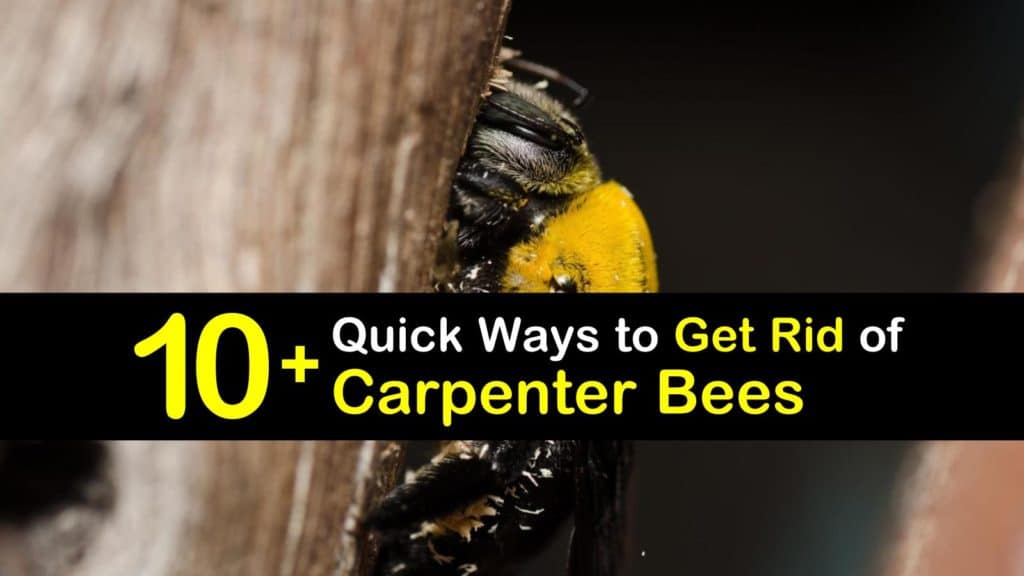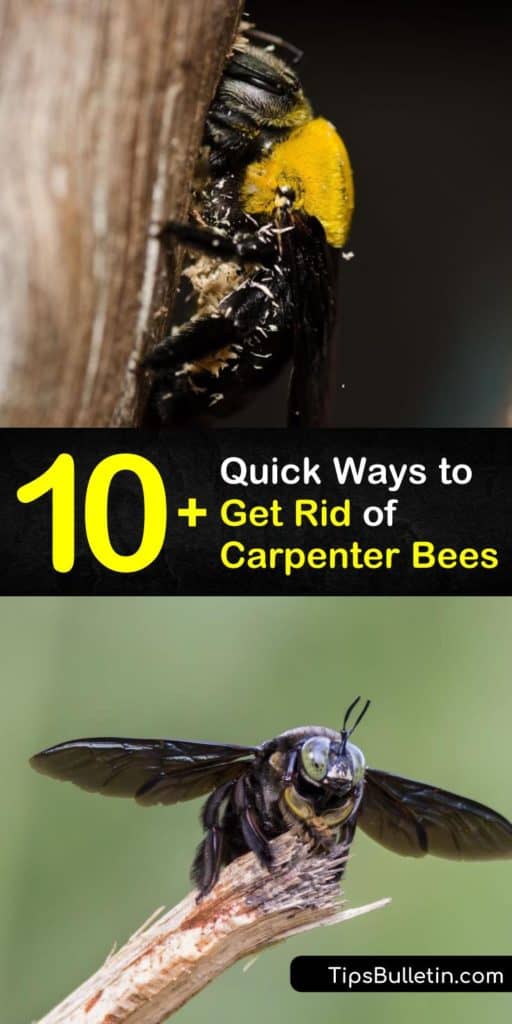How to Get Rid of Carpenter Bees Without Killing Them
Carpenter bees get their name for their infamous action of boring into wood and creating structural damage to homes, sheds, and other wooden structures. If you're suspicious of a carpenter bee infestation, it's best to take action sooner rather than later. Although most bees, like bumble bees, seem harmless, knowing how to get rid of carpenter bees is essential to the integrity of your home.
Bees are essential pollinators globally and are often welcome guests in our flower beds and veggie gardens. It's only when they decide to turn our homes into their nesting sites that they become a problem.
There are several natural ways to get rid of carpenter bees that are much more cost-effective than having to call pest control. We've provided a detailed guide to help you find the best way to get rid of carpenter bees around your home.

- Facts about Carpenter Bees
- How to Get Rid of Carpenter Bees
- What Types of Wood do They Attack?
- What to Look For
- Natural Ways to Get Rid of Carpenter Bees
- Use Caulk to Close Holes
- Make a DIY Citrus Spray
- The Best Way to Get Rid of Carpenter Bees
- Purchase a Duster
- Use Steel Wood to Close Bore Holes
- Aerosol Sprays
- Carpenter Bee Prevention
- When to Call Pest Control
Facts about Carpenter Bees
You can find a variety of bees in your yard, especially if you have a garden area. Some of them are terrific pollinators and others are just a nuisance. If it's in your lawn or garden, you want to get rid of ground bees nest so you don't accidentally disturb it.
As far as carpenter bees go, there are two types of carpenter bees, Xylocopa and Ceratina, or large and small carpenter bees. The most common type of carpenter bees around your home are the large Xylocopa. These bees grow anywhere from 12 to 25 millimeters long.
Their appearance is similar to a bumble bee. They are black and metallic blue with yellow hairs on their thorax, abdomen, and legs. The male carpenter bees also have yellow sections on their face.
Do you know what attracts carpenter bees? Carpenter bees are attracted to unfinished, weathered, or exposed wood. These bees do not eat the wood; instead, they dig tunnels into it and turn the tunnels into carpenter bee nests.
People often find these insects around the eaves of houses, in decks, siding, porches, and fascia boards. Carpenter bees become more serious the longer you let them use your home as a nest.
Over time, they expand their tunnels and cause significant structural damage. They also stain the wood with their feces.
Female carpenter bees are the only ones that sting when bothered because the males don't have stingers. Use these tips and home remedies for getting rid of carpenter bees around your property.
How to Get Rid of Carpenter Bees
If you've been looking for the best way to get rid of carpenter bees, this article is filled with tips and strategies that allow you to spot bore holes, implement your own carpenter bee control, and create homemade carpenter bee traps.
If you've found bore holes in your wood surfaces, keep reading to discover natural ways to get rid of carpenter bees.
What Types of Wood do They Attack?
One of the first locations to check for a carpenter bee infestation is around rails or posts from oak fences. The types of wood they prefer are softwoods like oak, redwood, cypress, pine, and fir.
Wood surfaces that are unpainted or unfinished are especially at risk. If the paint on wood has weathered, there is a chance that they will bore into those as well.
What to Look For
Carpenter bee holes are typically less than half an inch wide. They go perpendicular into the wood grain for an inch or two and then make a right angle turn that tunnels even deeper.
The female carpenter bee places a food ball in the nest, starts to lay eggs, and then blocks them off in a chamber where the bee larvae feed on the food. The female dies once she finishes this task.
For supporting evidence of a carpenter bee infestation, look for stained spots on the wood below bore holes. Another sign of carpenter bees is sawdust.
Since they aren't like termites that eat the wood, little sawdust piles are found under where they have burrowed. If you've seen these signs around your house, you're ready to start implementing natural ways to get rid of carpenter bees.
Natural Ways to Get Rid of Carpenter Bees
One of the best things to do when learning how to get rid of carpenter bees is to seal off all wood. What do bees hate? Carpenter bees don't like paint or varnish and prefer untreated wood.
Untreated or bare wood is much easier to drill into than wood with varnish or paint. Stroll around the perimeter of your property and make sure your house, shed, and fence have a fresh coat of paint.
Use Caulk to Close Holes
Carpenter bee holes will continue to be used regardless of if you paint the wood. Drive to your local hardware store and pick up a few tubes of caulk or wood putty. Walk around your yard and look closely for holes, filling them in with caulk as you go.
This filling is also an essential step because woodpeckers and carpenter bees go hand in hand. The bees construct their nests in the spring and, while their larvae develop, the woodpeckers detect their presence and drill even more holes into the wood to eat them.
Closing all the notches prevents the birds and the bees from causing further damage to your wooden structures.
Make a DIY Citrus Spray
Citrus is a natural repellent to carpenter bees and is also a treatment for carpenter ants. They hate the smell of citrus and making a homemade spray is both cheap and effective in your fight against them.
tb1234
Citrus Bee Repellent
- Citrus fruit
- Water
- Garden sprayer or spray bottle
tb1234
Depending on the amount you want to make, fill either a small or large pot with water and bring it to a boil. Slice several citrus fruit varieties like lemons, limes, and oranges, and place the slices in the boiling water.
Allow the fruit to boil for 20 minutes before removing the pot from the heat. Let the citrus water cool to room temperature before putting it in a garden sprayer or spray bottle. Spray the citrus into the bee holes and around the perimeter of your property.
The Best Way to Get Rid of Carpenter Bees
One of the most effective ingredients to use to get rid of carpenter bees is boric acid. Boric acid is a common household product and used for treating various insect problems.
tb1234
Boric Acid Bee Spray
- Boric acid
- Spray bottle
- Water
tb1234
For yellow jacket removal or to take care of carpenter bees, add three parts water and one part boric acid to the spray bottle and shake to mix. Spray the boric acid into each hole. The boric acid is poisonous to them, and any that come in contact with the spray die within the hour.
Purchase a Duster
A duster is a product that allows you to fill it with diatomaceous earth and spread a thin layer of it around the nest site.
Once the female comes in contact with the diatomaceous earth, she carries it inside, and it touches her eggs when she lays them. Diatomaceous earth is a powder substance that is harmful to insects' exoskeleton and dries them out until they die.
Use Steel Wood to Close Bore Holes
Among all the natural ways to get rid of carpenter bees, using steel wool and purchasing an insecticide or some types of pesticides is one of the easiest.
Soak a small amount of fine-grade steel wool in the insecticide and shove it into the carpenter bee hole. The carpenter bees spend a fair amount of time trying to chew through the wool while ingesting the insecticide and causing them to die.
Aerosol Sprays
If you're still having problems, the best way to get rid of carpenter bees is to purchase an aerosol spray.
Spraying these products into their nest sites and around the affected areas keeps the bees at bay and prevents them from laying any more eggs and causing an infestation.
Carpenter Bee Prevention
The best type of prevention from carpenter bees and the damage they cause is to put as many of the previously listed methods into place as possible. Try walking around your home and yard during the early spring and throughout the summer.
Checking on wood surfaces surrounding your home once every two weeks is the safest way to ensure that you keep them away from your home.
When you notice new holes, immediately seal them and spread diatomaceous earth or an insecticide around the area. Although carpenter bees are fantastic pollinators, some pesticides sprayed around your garden keeps them from hanging around at all.
When to Call Pest Control
A carpenter bee problem is typically something you can handle on your own, but there are times when reaching out and hiring a professional is your best option.
If you've tried every solution you could find on the internet, and you still can't get rid of the bees, it's time to call an exterminator for the safety of both you and your home.
Most homeowners like the sight of a few bees hanging around their garden and flower beds. It isn't until there are swarms of them and holes in every piece of wood around our homes that we consider them to be horrendous pests.
There are tons of home remedies for getting rid of carpenter bees, and you can't go wrong with any that you choose.

If you found it beneficial to learn how to get rid of carpenter bees, share these natural bee repellents on Facebook and Pinterest.
How to Get Rid of Carpenter Bees Without Killing Them
Source: https://www.tipsbulletin.com/how-to-get-rid-of-carpenter-bees/